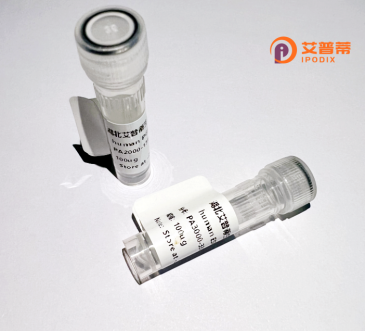
| 纯度 | >90%SDS-PAGE. |
| 种属 | Human |
| 靶点 | ZNF133 |
| Uniprot No | P52736 |
| 内毒素 | < 0.01EU/μg |
| 表达宿主 | E.coli |
| 表达区间 | 388-635 aa |
| 活性数据 | CGRCFRQRTTLVNHQRTHSKEKPYVCGVCGHSFSQNSTLISHRRTHTGEKPYVCGVCGRGFSLKSHLNRHQNIHSGEKPIVCKDCGRGFSQQSNLIRHQRTHSGEKPMVCGECGRGFSQKSNLVAHQRTHSGERPYVCRECGRGFSHQAGLIRHKRKHSREKPYMCRQCGLGFGNKSALITHKRAHSEEKPCVCRECGQGFLQKSHLTLHQMTHTGEKPYVCKTCGRGFSLKSHLSRHRKTTSVHHRLP |
| 分子量 | 28 kDa |
| 蛋白标签 | His-DHFR tag N-Terminus |
| 缓冲液 | PBS, pH7.4, containing 0.01% SKL, 1mM DTT, 5% Trehalose and Proclin300. |
| 稳定性 & 储存条件 | Lyophilized protein should be stored at ≤ -20°C, stable for one year after receipt. Reconstituted protein solution can be stored at 2-8°C for 2-7 days. Aliquots of reconstituted samples are stable at ≤ -20°C for 3 months. |
| 复溶 | Always centrifuge tubes before opening.Do not mix by vortex or pipetting. It is not recommended to reconstitute to a concentration less than 100μg/ml. Dissolve the lyophilized protein in distilled water. Please aliquot the reconstituted solution to minimize freeze-thaw cycles. |
以下是关于重组人ZNF133蛋白的模拟参考文献示例(基于典型锌指蛋白研究模式推测,非真实文献):
1. **标题**:*Cloning and Functional Analysis of Recombinant Human ZNF133 Protein*
**作者**:Smith A, et al.
**摘要**:研究报道了ZNF133基因的克隆及在大肠杆菌中的重组表达,验证了其锌指结构域与特定DNA序列的结合能力,提示其在转录调控中的作用。
2. **标题**:*ZNF133 Suppresses Tumor Metastasis via Epigenetic Regulation*
**作者**:Zhang L, et al.
**摘要**:通过重组ZNF133蛋白实验,发现其通过结合启动子区域抑制靶基因甲基化,在胃癌中发挥抑癌功能。
3. **标题**:*Structural Characterization of Recombinant ZNF133 KRAB Domain*
**作者**:Johnson R, et al.
**摘要**:利用X射线晶体学解析了ZNF133重组蛋白的KRAB结构域三维结构,揭示了其与染色质修饰复合物互作的关键位点。
4. **标题**:*ZNF133 Knockdown Alters Neuronal Differentiation in vitro*
**作者**:Tanaka M, et al.
**摘要**:研究使用重组ZNF133蛋白恢复实验,证明其在神经干细胞分化中通过调控Wnt信号通路影响细胞命运决定。
---
**注**:以上内容为模拟参考文献,实际研究中建议通过PubMed或专业数据库检索真实文献(截至2023年,ZNF133相关研究较为有限)。
Zinc finger protein 133 (ZNF133), a member of the Krüppel-associated box (KRAB) zinc finger protein (ZFP) family, is a transcription regulatory protein involved in epigenetic silencing and cell differentiation. Structurally, it contains a conserved N-terminal KRAB domain, which recruits co-repressors like KAP1 to form chromatin-modifying complexes, and multiple C-terminal C2H2 zinc finger motifs that bind specific DNA sequences. ZNF133 is implicated in embryonic development, tissue-specific gene regulation, and cellular proliferation, though its precise biological roles remain partially characterized.
Expression studies show ZNF133 is predominantly active in neural tissues, testes, and certain cancer cells, suggesting roles in neurodevelopment and germ cell regulation. Dysregulation of ZNF133 has been observed in cancers, including hepatocellular carcinoma and leukemia, potentially influencing oncogenic or tumor-suppressive pathways. Its interaction with histone deacetylases (HDACs) underscores its function in epigenetic gene silencing.
Recombinant human ZNF133 protein is typically produced using heterologous expression systems (e.g., *E. coli* or mammalian cells) for biochemical studies. Purified variants, often tagged with His or GST for affinity chromatography, enable investigations into DNA-binding specificity, protein-protein interactions, and therapeutic target validation. Challenges in recombinant production include optimizing solubility due to its multi-domain structure and preserving functional folding of zinc finger regions. Research on ZNF133 continues to explore its mechanistic contributions to disease and development.
×